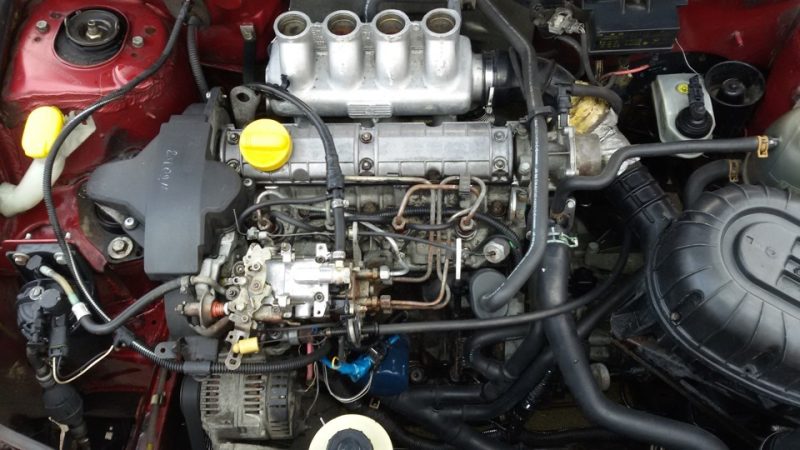Characteristics
| Characteristics | Value |
|---|---|
| Manufacturing | Cleon Plant |
| Engine brand | F-series |
| Years of manufacture | 1988-2007 |
| Cylinder block material | Cast iron |
| Engine type | Diesel |
| Configuration | Ready |
| Number of cylinders | 4 |
| Valves per cylinder | 2 |
| Piston stroke, mm | 93 |
| Cylinder diameter, mm | 80 |
| Compression ratio | 21.5, 20.5 |
| Engine displacement, cc | 1870 |
| Engine power, hp/rpm | 55/3900, 64/4500, 90/4250 |
| Torque, Nm/rpm | 123/2250, 118/2250, 176/2000 |
| Environmental regulations | Euro 0, Euro 1, Euro 2 |
| Turbocharger | Garrett GT1544S |
| Engine weight, kg | – |
| Fuel consumption, l/100 km (city / highway / mixed for Renault Megane 1) | 9.0/6.7/5.3 |
| Oil consumption, gr./1000 km | To 1000 |
| Engine oil | 10W-40 |
| How much oil in the engine, liters | 4.7 |
| Oil change is carried out, km | 15000 (better 7500) |
| Engine operating temperature, deg. | 90 |
| Engine life, thousand kilometers | Factory data: -, In practice: 300+ |
| Tuning, h.p. | Potential: -, Without loss of resource: – |
| Motor installed | Renault Megane I, Mitsubishi Carisma, Renault 19, Renault Clio I, II, Renault Express, Renault Kangoo I, Renault Scenic I, Volvo 460, Volvo S40 |
Reliability, problems and repair of F8Q engines
The discussed 4-cylinder engine was released in 1988 as a replacement for the 1.6-liter F8M and was first intended for the Renault 19 car, later it spread to many Renault models and caught even Volvo. The engine is based on a cast iron block with a cylinder bore of 80mm, inside on 5 supports is a crankshaft with a 93mm piston stroke and 139mm long connecting rods. All this gives 1.87 liters of working volume, which is rounded up to 1.9 liters.

This block is fitted with an aluminum head with forkamers, a single camshaft and 2 valves per cylinder. The intake valves measure 35.2mm, exhaust valves 31.5mm, and the valve stem is 8mm thick. Valve adjustment is required approximately every 50 thousand kilometers, valve clearance on cold: inlet 0.2 mm, outlet 0.4 mm.
The camshaft is rotated by a timing belt, which requires replacement after 60 thousand kilometers. If missed, there is an increased risk of breakage, and breakage = bent valves.
Injection uses a Lucas fuel injector, but there were also modifications with a Bosch VE pump.
Since 1990, a turbo version of the F8Qt has been in production, where the compression ratio was reduced from 21.5 to 20.5, and a Garrett GT1544S turbine with intercooler was used. Thanks to this it was possible to increase power from 64 hp to 90 hp, torque increased from 118 Nm to 176 Nm. Cars with this engine have the prefix dT.
Since 1997, for several years, this motor was displaced by more modern F9Q, but on Renault Kangoo F8Q stayed until 2007.
F8Q engine problems and faults
Pre-1997 engines have problems with cracks in the cylinder head in the fork chamber area. This can be recognized by oil in the antifreeze. It is also possible for the cylinder-head gasket to burn through.
Otherwise, the motor is not bad at all, in its time it went 300-400 thousand kilometers and more without problems, but at the moment they have all rolled out their resource, so today it is not necessary to talk about reliability. This is an old engine, in which anything can break down and whenever. Regularly and tolerably maintain it, in this case the diesel will still run.
F8Q engine tuning
Chip tuning
This is one of the few engines, which is not finalized by anyone at all and there is no sense in it, because of its old age and wear and tear. If you want, you can find craftsmen to make you 100+ hp, but it’s hardly worth it.
MOTOR RATING: 4-
